A Complete Guide to Choosing and Caring for Cooking Pans
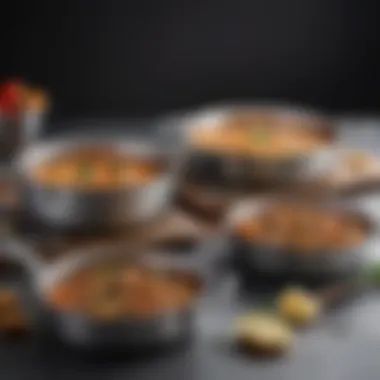
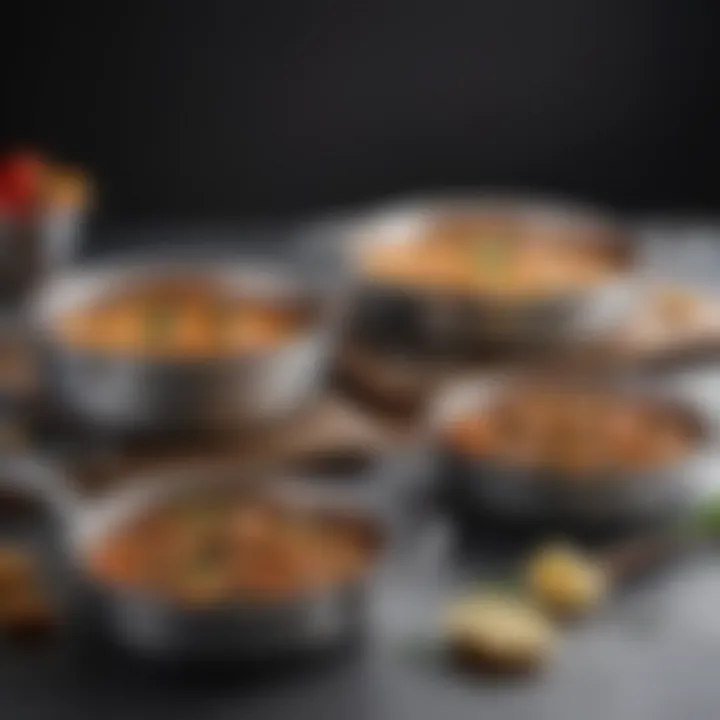
Intro
Cooking pans are an essential part of the kitchen, playing a crucial role in diverse culinary tasks. Understanding the different types of pans available, from non-stick skillets to stainless steel sauté pans, is vital for anyone looking to enhance their cooking experience. This guide aims to unravel the complexities of cooking pans by detailing the specific advantages of each type, materials used, and practical care routines.
Made from various materials such as aluminum, cast iron, and stainless steel, each pan offers unique benefits tailored to specific cooking techniques. Selection is not merely about preference; it involves consideration of cooking style, dietary needs, and even maintenance preferences. With busy lifestyles, it becomes increasingly important to choose pans that can endure regular use and provide efficient cooking results.
Ultimately, this comprehensive guide will offer insightful perspectives on pan selection that is aligned with culinary goals. It will address fundamental aspects, enabling busy individuals to make informed choices and effectively maintain their cooking essentials.
Choosing the Right Pan
To start, selecting the right cooking pan will ensure that you maximize performance and efficiency in the kitchen. Here, we present an overview of some prominent pan types:
- Non-Stick Skillets: Ideal for low-fat cooking, these pans minimize food sticking, yet require gentle utensils to avoid damaging the surface.
- Cast Iron Skillets: Praised for their heat retention and rugged durability, cast iron is perfect for searing meat or baking dishes—though they do require specific care to maintain their seasoning.
- Stainless Steel Pans: Known for their corrosion resistance and ability to withstand high heat, stainless steel pans offer versatility, great for browning and deglazing.
- Chef’s Frying Pans: A hybrid typically used for sautéing, they combine features of different pan types, suitable for quick cooking methods.
Effective Usage of Cooking Pans
Understanding the use-case and method for each pan can elevate your cooking skills.
- Maintain an appropriate heat level specific to the composition of the pan. For instance, metal pans suit high-heat methods better than non-stick.
- Adjust cooking times according to material. Cast iron requires longer to heat but retains heat exceptionally well; therefore, once heated, cook adjustments may need less monitoring, giving flexibility.
With proper selection and use, cooking pans can enhance your culinary undertakings. Care tips follow to help ensure their longevity.
Care Routines for Longevity
Maintaining your pans is vital for sustaining their performance and lifespan. Consider these practical routines:
- Non-Stick Care: Avoid abrasive cleaning materials. Hand wash with mild detergent and ensure complete drying before storage.
- Cast Iron: After use, wash with hot water, using a brush to clear remnants. Immediately dry them and apply a thin layer of seasoned oil to maintain the surface.
- Stainless Steel: Clean with warm soapy water; for tougher stains, vinegar can restore shine. Remember to avoid induction heat settings for elderly stainless cookware.
Taking proper care of cooking pans not only ensures their continued efficiency but preserves their aesthetic quality. That's essential in busy kitchens where appliances get put through rigorous daily usage.
End
Ultimately, cooking pans are pivotal to successful food preparation. By thoroughly understanding their types, functions, and care practices, individuals can maximize potential in the kitchen. This guide encourages conscious decision-making in selecting and maintenance, prospects for success in culinary ventures.
Understanding Cooking Pans
Cooking pans are a central part of any kitchen. Their diverse types and forms allow for a range of cooking methods, making them essential tools for preparing meals. The appropriate choice of a pan can elevate cooking and bring out the best in ingredients.
The Importance of Choosing the Right Pan
Selecting the right cooking pan has a direct impact on the quality and flavor of the food. Correct pans not only facilitate even heat distribution but also assist in achieving desired textures. Ignoring this aspect often translates to overcooked, undercooked, or uneven meals. Each cooking method requires specific attributes that only particular materials or shapes can provide. Thus, understanding the nuances involved in choosing a pan becomes key to progress along the culinary spectrum.
Common Types of Cooking Pans
Different cooking pans serve specialized purposes that streamline meal preparation. An assortment gives cooks access to an array of cooking techniques to suit their individual styles.
-### Frying Pans Frying pans or skillets are designed for the quick cooking of food at high temperatures, making them perfect for frying, sautéing, or browning ingredients. Their characteristic flat bottom allows easy access to food while facilitating hot spots, depending on the heat source used. Found in diverse materials like non-stick, stainless steel, and more, frying pans provide flexibility. However, non-stick versions can wear out over time, requiring careful usage to maximize lifespan.
-### Saucepans Saucepans are vital for preparing sauces, boiling pasta, or simmering liquids. Their broader base allows liquids to heat evenly, and they usually come with high sides. This feature prevents splatters while cooking. Moreover, saucepans typically include a lid, making it easy to trap steam and enhance flavors. Less heat retention may lead to gradual temperature drops even with lidded cooking, so attentiveness is required for best results.
-### Skillets Skillets often overlap with frying pans but offer specific designs meant for versatile cooking. They usually have slightly higher edges, allowing comfortable handling of larger ingredients like frittatas or masses of sautéed vegetables. Skillets that feature a non-stick coating simplify cleanup but must be well-maintained to avoid degradation. This combination of characteristics make skillets a reliable choice for kitchen enthusiasts across a spectrum of dishes.
-### Stock Pots Stock pots dominate in the realm of stewing, large batch cooking, or boiling stock. Their tall, wide bodies enable exceptional heat distribution and fluid retention. Commonly constructed from durable materials, they are capable of handling high temperatures like those seen in broth preparation. A downside might be that due to their size, stock pots can prove cumbersome for smaller cooking tasks that might be easier in smaller, specialty vessels.
-### Roasting Pans The design of roasting pans caters to roasting meat and vegetables. A broad base encourages even cooking while sufficient height helps to catch stray juices neatly. Roasting pans include shallow designs that amplify caramelization, a quality sought after in roasting preparation. Yet, sometimes the heavier models can be hard to maneuver, especially when transferring from oven to counter without spilling.
Understanding different types of cooking pans—and their functions—assists you in employing the right tools. Again, this not only contributes to better food preparation but also enhances enjoyment in the cooking process.
Materials Used in Cooking Pans
The material of cooking pans is foundational to their performance and suitability for various culinary tasks. Choosing the right material impacts not only how the pan functions but also how it affects the cooking process, including heat retention, cooking efficiency, and even changes in flavors. Pans made from different materials exhibit unique properties, making understanding these materials essential for achieving desired results in the kitchen.
Stainless Steel
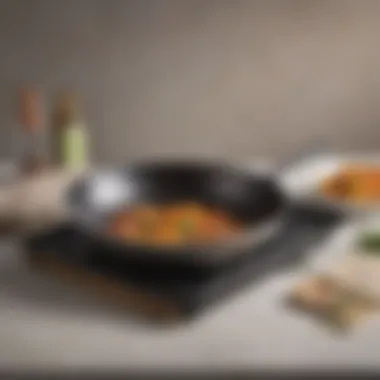
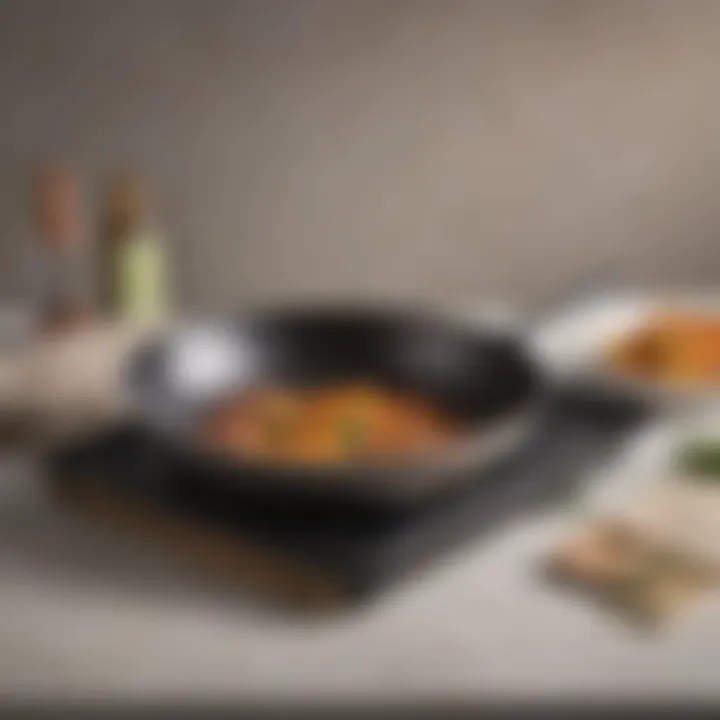
Stainless steel pans are known for their durability and resistance to corrosion. They provide an excellent balance between performance and maintenance. The non-reactive nature of stainless steel allows for cooking a wide range of foods without altering their taste. Moreover, stainless steel maintains heat well, which aids in even cooking.
Another significant benefit is the various options in construction. Some stainless steel pans come with an aluminum or copper core, enhancing heat distribution. With careful selection, these cores can improve cooking performance greatly.
However, it is important to practice proper heating techniques to avoid food sticking.
Cast Iron
Cast iron pans are lauded for their remarkable heat retention and ability to distribute heat evenly across the surface. This characteristic makes them particularly suitable for searing meats and maintaining high cooking temperatures. Additionally, cast iron develops a natural non-stick surface with seasoning, which enhances with each use.
Nonetheless, cast iron requires regular care to prevent rust and preserve its seasoned surface. Heavy and often more cumbersome than other pans, it also takes time to adjust for novices.
Non-Stick Coatings
Non-stick pans offer convenience through reduced friction, allowing for easier meal release and less oil usage in cooking. This feature caters well to those concerned with health and calorie count. Many non-stick surfaces feature advanced technology, providing good durability against scratching and wear.
Despite these benefits, it's essential to understand the care instructions associated with non-stick cookware, as improper use can damage their surfaces. Furthermore, overheating can compromise their lifecycle, leading to health concerns. Selecting non-stick pans free of harmful chemicals is advisable.
Copper
Copper pans excel in thermal conductivity, making them excellent for precise temperature control. Chefs often choose copper for delicate cooking, where uniform heating is essential, such as with pastries or sauces. Copper cookware can also enhance presentation in certain contexts, making it appealing for beautiful plating.
However, copper demands generosity in terms of both upkeep and price. Many copper pans include other metals like stainless steel to create a durable and functional layer while maintaining the benefits of copper. The issue of reactivity with acidic foods should also be considered, as it may lead to undesirable flavors without proper treatment.
Understanding the materials behind cooking pans enables one to choose pots and pans that mesh seamlessly with personal cooking methods and preferences.
Choosing the Right Cooking Pan
Choosing the right cooking pan is essential in enhancing your culinary experience. It influences not just the cooking process, but also the outcome of your meals. The type of pan you prioritize should reflect your cooking methods and the kinds of dishes you prepare regularly. This ensures an effective cooking process and optimal taste. Choosing an incorrect pan may lead to uneven cooking or dissatisfaction with food texture. It is, thus, crucial to consider various elements that shape your choice of cooking pans.
Factors to Consider
Cooking Method
The cooking method you employ significantly alters what kind of pan you should select. Different methods such as frying, sautéing, or simmering require specific pans designed to handle high temperatures or retain heat. For instance, a frying pan is suited for quick sears to meats or stir-frying vegetables while a saucepan excels in slow cooking sauces.
It is essential to identify whether you will be mainly frying, baking, or steaming foods because each of these cooking techniques performs best with certain pans. Skillets, for example, tend to have a wider cooking surface that cooks food faster, making them a popular choice for tasks demanding high heat. If you prefer steaming food, selecting a pot with a steam insert is also wise. Understanding your routine will help in achieving the best results in the kitchen.
Heat Distribution
Heat distribution plays a critical role in the success of any recipe. Pans that heat unevenly often lead to burnt spots or unevenly cooked food. Materials such as copper or clad stainless steel enhance heat distribution and retention. This means your food can cook at a consistent temperature. Copper pans, for instance, are known for their exceptional response to changes in heat.
One of the main advantages of choosing a pan with great heat distribution is achieving uniform cooking. You have to pay attention to the manufacturer's specifications regarding heat sources — some pans cannot be placed on certain stovetops and may require specific care.
Size and Depth
The size and depth of your cooking pan not only determine what you can cook but also how much you can prepare. A shallow frying pan may enable you to brown meat efficiently but can complicate simmering larger quantities of sauce. Thus, considering the usual portion sizes you prepare is crucial. A deeper saucepan can enhance the versatility of what meals you can prepare in it.
Larger pans can be beneficial for stews, while smaller, more compact options are preferred for quick sides. Ensuring adequate size and depth aligns with your cooking aims will streamline your kitchen experience.
Budget Considerations
While quality is paramount, budget also cannot be overlooked when choosing cooking pans. There is a wide array of options that cater to various price points. Investing in a high-quality new pan might be reasonable for someone who cooks frequently. On the other hand, if cooking is infrequent, a mid-priced pan could serve adequately. It is crucial to evaluate not just cost, but the durability, and warranty options as well.
Ultimately, making an informed decision about choosing your cooking pan could well serve you for years. Thus, do your research and consider your specific culinary needs.
Using Cooking Pans Effectively
Using cooking pans effectively is vital for every culinary enthusiast. This section emphasizes the techniques needed to maximize the performance of your cooking pans, ensuring efficient cooking while preserving the quality of both food and pans. Proper use of pans enhances your ability to prepare various dishes and contribute to a more enjoyable cooking experience.
Preheating Techniques
Preheating is often an underrated step, yet it is crucial for achieving optimal cooking results. When using most cooking pans, particularly stainless steel and cast iron, preheating allows them to reach the desired temperature before adding food. This improves food browning and prevents sticking, which is essential for achieving the right texture and taste.
- Start with medium heat, allowing the pan to warm up gradually.
- To verify that the pan is preheated, sprinkle a few drops of water on its surface. If the droplets sizzle and evaporate quickly, your pan is ready.
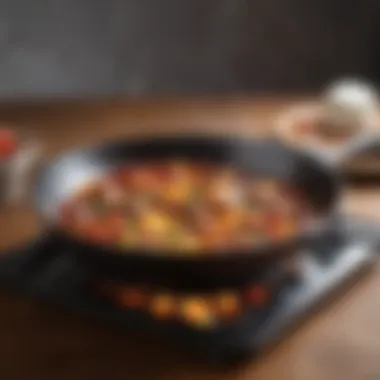
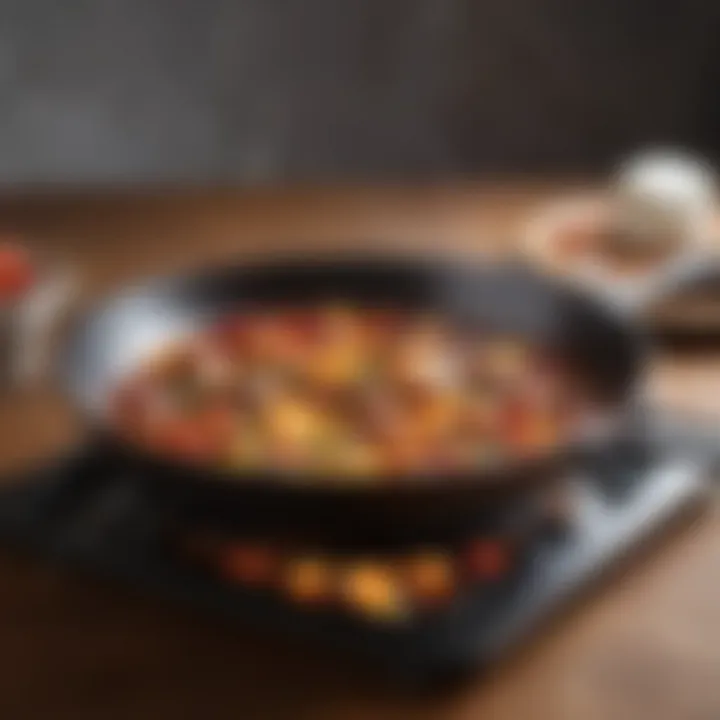
Effective preheating leads to better flavor extraction, ensuring that meals are cooked evenly. The integrity of the flavours hinges on adequately prepared pans, avoiding burnt or improperly cooked meals.
Avoiding Common Pitfalls
Common pitfalls can derail even the most experienced chef. First, over-filling a pan typically affects cooking times and temperature, often leading to steam instead of searing. Secondly, using the wrong utensils can damage coatings or scratch surfaces, especially with non-stick pans. Instead, opt for wooden or silicone utensils to maintain the integrity of your pans.
- Avoid sudden temperature changes; for example, do not pour cold substances into a hot pan.
- Make sure to regulate heat according to the type of pan and the recipe you are following, preventing potential damage.
Learning these common errors and ensuring their avoidance will not only extend the lifespan of your pans but also elevate the quality of your cooking.
Best Practices for Different Pans
Using Cast Iron
Cooking with cast iron brings distinct advantages. The key characteristic of cast iron pans is their heat retention and ability to develop a naturally non-stick surface over time if maintained correctly. They are an excellent choice for those looking for sturdiness alongside flavor enhancement.
A unique feature of using cast iron is its suitability for high-heat cooking methods like searing. Foods such as steaks are beautifully cooked, delivering desired flavors while locking in juices. However, this comes with some disadvantages. For example, cast iron requires proper seasonig and continuous maintenance to prevent rust; otherwise its performance can degrade.
Maintaining Non-Stick Coatings
Understanding how to maintain non-stick coatings is essential for energy-efficient cooking. The key characteristic of non-stick pans is their ability to allow for cooking with minimal fats, which can promote healthier meal options. They are a popular choice for busy individuals who need quick and simple cooking methods.
The unique aspect here is the need to keep cooking temperatures moderate. High heat can damage the coating, reducing its effectiveness over time. Scratching the surface with metal utensils can exacerbate this. Instead, keep your non-stick pan safe by using softer utensils. Moreover, avoid abrasive sponges during cleaning, as they may strip away the coating. By adhering to these practices, the lifespan and non-stick quality of these pans can be maximized.
Caring for Your Cooking Pans
Caring for your cooking pans is crucial for maintaining their functionality and extending their lifespan. Each type of pan requires different care and cleaning techniques. Proper maintenance not only preserves the quality of your pans but also enhances your cooking experience. It ensures that food cooks evenly, reduces sticking, and prevents unwanted flavors from developing over time. Understanding how to care for your pans yields significant benefits that go beyond mere aesthetics.
Cleaning Techniques
Hand Washing vs.
Dishwasher
When it comes to cleaning cooking pans, the choice between hand washing and using a dishwasher can greatly affect their longevity. Hand washing allows for more control over the cleaning process, ensuring that delicate finishes are preserved. Many cookware materials, such as cast iron and non-stick, can be damaged in a dishwasher. Additionally, some residues might not come off completely in a machine.
In contrast, using a dishwasher is undoubtedly convenient. It's a time-saver, allowing culinary enthusiasts to clean multiple items with ease. Dishwashers use high temperatures, which can effectively kill bacteria. However, it's essential to remember that not all pans are dishwasher-safe. For instance, a stainless steel or enameled cast iron pan may withstand dishwashers fine, but the non-stick surfaces can get scratched or lose their coating over time.
Key Features of Each Method
- Hand Washing: More gentleness, better control, suitable for fragile surfaces.
- Dishwasher: Convenient, high-temperature cleaning, suitable for stronger materials.
Ultimately, the decision may come down to the types of pans you own and their specific care instructions.
Removing Stains and Residue
Stains and residues can diminish the performance and appearance of your cooking pans. Removing stains effectively contributes to better health and safety when preparing food. Residue buildup can lead to unpleasant flavors in your meals, impacting the overall quality of your cooking efforts.
There are various techniques for removing stains and tough residues. For example, using a baking soda paste can effectively lift stubborn stains from stainless steel surfaces. Vinegar is also useful for eliminating discoloration and can serve as a natural cleaning agent for coated surfaces. On the other hand, certain commercial cleaners may contain harsh chemicals that could harm the pan’s finish, thus shouldn’t be the go-to choice.
Helpful Techniques
- Apply a paste of baking soda and water, then scrub gently.
- Use vinegar to soak sticky residues or stains, providing natural acid to break it down.
Maintaining your pans by effectively removing stains guarantees a clean cooking surface and helps preserve the quality of your meals over time.
Preventive Maintenance
Preventive maintenance is key in preserving the quality and effectiveness of your cooking pans. Regularly checking for any signs of damage, such as warped surfaces or peeling coatings, safeguards against further deterioration. Seasoning cast iron pans can prevent rust and maintain their non-stick properties, ensuring that they perform beautifully for years to come.
Regular maintenance practices can include storing pans correctly to avoid scratching and the buildup of grime. Keeping lids off of pans when stacking can reduce moisture buildup that leads to rust or peeling.
Always take note of specific recommendations from the manufacturers for care routines. This attention to detail will not only help in protecting your investments in cookware but also ensure you enjoy safe and efficient cooking in your kitchen.


The Impact of Cooking Pans on Food Quality
Choosing the right cooking pan significantly influences the overall quality of food prepared. The materials and construction of a pan can impact heat retention and distribution, ultimately affecting cooking results. Understanding how these factors work aids culinary enthusiasts in elevating their cooking experience. Good pans don't just cook; they contribute to the flavor and texture of meals. Neglecting this aspect can lead to subpar dishes, while optimal choices can enhance both taste and presentation.
Heat Retention and Distribution
Heat retention and distribution are critical when using cooking pans. Different materials conduct heat in unique ways. For instance, cast iron retains heat very well, allowing for consistent cooking temperatures once hot. This is commonly advantageous for tasks like frying where even cooking is vital.
Moreover, some materials, such as stainless steel, do not conduct heat evenly by themselves. Brands like Cuisinart and All-Clad often use aluminum or copper cores to enhance heat distribution. Good heat distribution prevents hot spots, which can burn food in some areas while leaving others undercooked. As such, selecting a pan that ensures an even distribution can greatly improve results, leading to more gourmet-like outcomes in home cooking.
Tip: A heavy-bottomed pan may offer improved heat retention and reduce the chance of warping during high temperatures.
Flavor Enhancement
Cooking pans also play a fundamental role in enhancing flavors. Specific foods react differently to various materials. For example, cooking acidic ingredients, like tomatoes, in certain non-reactive pans made of stainless steel preserves the taste better than when cooked in aluminum, which may change the flavor profile.
Additionally, pans with non-stick coatings, such as those from Teflon or ceramic materials, require less oil. This change makes sauces lighter, allowing the natural flavors of ingredients to shine through without the heaviness added from excessive fats. It’s this aspect of culinary science that often separates home cooks from professionals.
In summary, the interaction between the cooking pan material and the food's properties leads to varying taste results. Culinary practices should consciously consider the improving effect cooking pans have on flavors.
Choose your cooking pans wisely; they are not just vessels, but critical instruments of flavor co-creation.
Exploring Innovative Cooking Pan Technologies
The world of cooking pans is undergoing significant evolution. Traditional materials and methods now blend with advanced technologies, enhancing performance and user experience. Innovative cooking pan technologies are essential in this comprehensive guide. They provide solutions that simplify cooking routines, improve food quality, and extend the lifespan of kitchen equipment.
As culinary enthusiasts, understanding these innovations is crucial. They impact several factors that are vital in the kitchen, like heat retention, cooking times, and ease of cleaning. When selecting kitchenware, a grasp of modern pan technologies influences not only your cooking efficiency but also your dishes’ taste and presentation.
Advancements in Non-Stick Surfaces
Non-stick surfaces have come a long way since their inception. The earlier non-stick coatings, such as Teflon, raised concerns over safety. Today, manufacturers are producing more advanced solutions. Contemporary options may incorporate ceramic or titanium-infused coatings. These newer materials offer improved durability while maintaining their essential non-stick properties. It helps in achieving better food release without the need for excessive fats or oils.
Benefits of modern non-stick surfaces include:
- Easy Food Release: Allows for uncomplicated cooking and cleanup, suitable for busy individuals.
- Lower Fat Cooking: Supports healthier meal preparation, aligning with today's dietary preferences.
- Durability: Newer coatings resist scratching and withstand higher cooking temperatures, enhancing their performance.
While selecting non-stick cookware, consider brands known for technological advancements in coatings, for example, GreenPan or ScanPan. These companies invest in developing surfaces that endure wear and protect your health by avoiding chemical leaching.
Smart Cooking Pans
Smart cooking pans represent the cutting edge of kitchen technology. These innovations integrate technology to provide data-driven cooking solutions. They often connect to smartphones via apps for better meal preparation accuracy.
Features of smart cooking pans can include:
- Temperature Control: Many models come with built-in sensors to regulate heating, ensuring perfect results.
- Recipe Guidance: They may offer step-by-step cooking instructions, aiding novice chefs in achieving professional outcomes.
- Cooking Alerts: Systems for notifications help prevent burning and undercooked meals by alerting users during cooking processes.
Using smart pans can dramatically enhance your cooking. However, these innovations often require regular updates, and there might be too many features for some users. Balance is advisable. While smartphones transform our daily lives, simpler may still be better in a kitchen where time is a luxury.
The integration of innovative technologies in cooking tools is essential. They can greatly minimize the effort needed for creating culinary delights and ensure you enjoy the cooking process.
In the end, staying informed on new cooking technology helps you make wiser choices as a home cook or culinary expert. As innovations continues to progress, your kitchen setup can be both efficient and aligned with modern trends, optimizing the cooking experience.
Culmination
Choosing and caring for cooking pans is a fundamental aspect of a successful culinary practice. This article has explored various types of pans, their materials, and best usage techniques, serving to provide a holistic guide to improve not just cooking efficiency but also the quality of food prepared.
The synergy between different cooking methods and appropriate pan selection plays a major role in both health and flavor. Understanding different materials such as stainless steel and cast iron allows for tailored cooking experiences suited to specific dishes. Any culinary enthusiast, whether seasoned or novice, should not underestimate the impact their cookware has on overall outcomes.
Summary of Key Points
In reviewing the key components of this guide, several important themes emerged:
- Diversity of Pans: Knowing the various types of pans and their specific uses is essential for anyone serious about cooking.
- Materials Matter: Each material affects cooking dynamics such as heat retention, speed, and flavor enhancement.
- Proper Use Enhances Outcome: Instilling best practices for each type of pan magnifies their effectiveness and minimizes common mistakes.
- Now Maintenance Is Key: Good care prolongs the lifespan of the cookware, saving time and resources in the long run.
- Innovation in Cookware: Staying informed on new technologies in cookware can greatly benefit cooking experiences.
Adopting a tolerant approach toward cooking and equipment can significantly enhance culinary enjoyment.
Encouragement for Optimal Cooking Practices
Emphasizing the importance of using the right tools invites individuals to develop thoughtful cooking routines. Familiarity with personal culinary style is crucial. This guide intends not only to inform but to inspire continuous learning in efficient kitchen practices.
Visit communities where culinary enthusiasts gather, like reddit.com, to exchange ideas on using different pans, or take time to converse with knowledgeable chefs on Facebook. Heroic improvements await those willing to apply the principles noted in this article. Every pan has a potential story to share—but the practitioner must be equipped with the right knowledge to write it.







